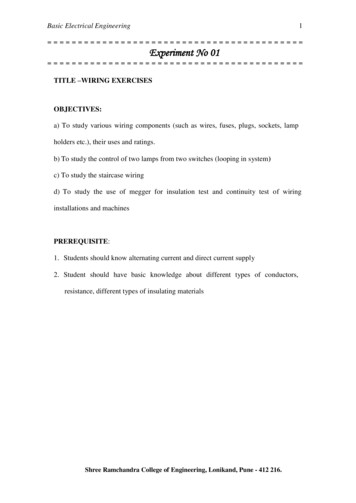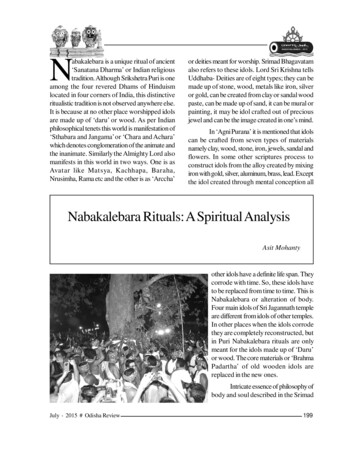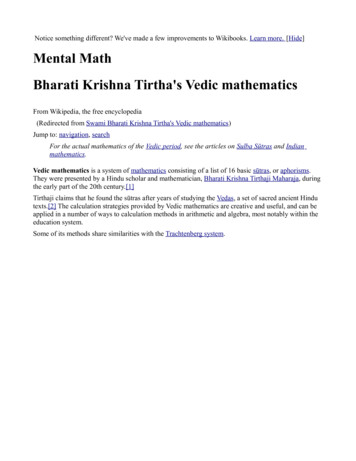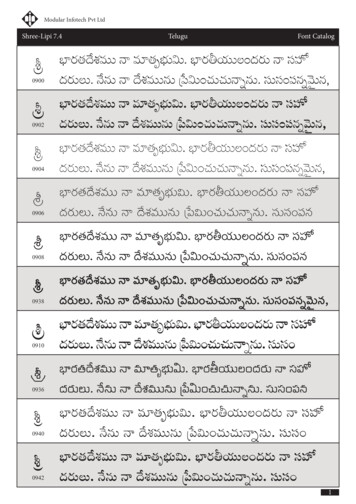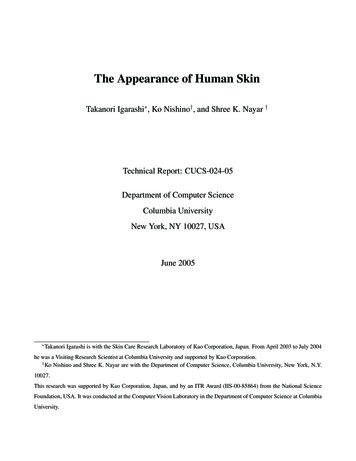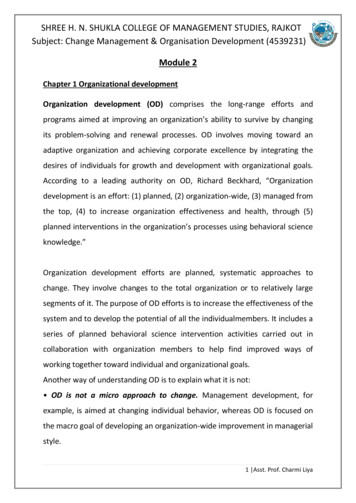
Transcription
SHREE H. N. SHUKLA COLLEGE OF MANAGEMENT STUDIES, RAJKOTSubject: Change Management & Organisation Development (4539231)Module 2Chapter 1 Organizational developmentOrganization development (OD) comprises the long-range efforts andprograms aimed at improving an organization’s ability to survive by changingits problem-solving and renewal processes. OD involves moving toward anadaptive organization and achieving corporate excellence by integrating thedesires of individuals for growth and development with organizational goals.According to a leading authority on OD, Richard Beckhard, “Organizationdevelopment is an effort: (1) planned, (2) organization-wide, (3) managed fromthe top, (4) to increase organization effectiveness and health, through (5)planned interventions in the organization’s processes using behavioral scienceknowledge.”Organization development efforts are planned, systematic approaches tochange. They involve changes to the total organization or to relatively largesegments of it. The purpose of OD efforts is to increase the effectiveness of thesystem and to develop the potential of all the individualmembers. It includes aseries of planned behavioral science intervention activities carried out incollaboration with organization members to help find improved ways ofworking together toward individual and organizational goals.Another way of understanding OD is to explain what it is not: OD is not a micro approach to change. Management development, forexample, is aimed at changing individual behavior, whereas OD is focused onthe macro goal of developing an organization-wide improvement in managerialstyle.1 Asst. Prof. Charmi Liya
SHREE H. N. SHUKLA COLLEGE OF MANAGEMENT STUDIES, RAJKOTSubject: Change Management & Organisation Development (4539231)OD is not any single technique. OD uses many different techniques, such astotal quality management or job enrichment, and none of them by itselfrepresents the OD discipline. OD does not include random or ad hoc changes. OD is based on a systematicappraisal and diagnosis of problems, leading to planned and specific types ofchange efforts. OD is not exclusively aimed at raising morale or attitudes. OD is aimed atoverall organizational health and effectiveness. Participant satisfaction may beone aspect of the change effort, but it includes other effectiveness parametersas well.Organization development is an emerging discipline aimed at improving theeffectivenessof the organization and its members by means of a systematicchange program. Chester Barnard and Chris Argyris, among other managementtheorists, have noted that a truly effective organization is one in which boththe organization and the individual can grow and develop.An organization with such an environment is a “healthy” organization. The goalof organization development is to make organizations healthier and moreeffective. These concepts apply to organizations of all types, including schools,churches, military forces, governments, and businesses.The Characteristics of Organization DevelopmentTo enlarge upon the definition of OD, let us examine some of the basiccharacteristics of OD programs.2 Asst. Prof. Charmi Liya
SHREE H. N. SHUKLA COLLEGE OF MANAGEMENT STUDIES, RAJKOTSubject: Change Management & Organisation Development (4539231) Change. OD is a planned strategy to bring about organizational change. Thechange effort aims at specific objectives and is based on a diagnosis of problemareas. Collaborative approach. OD typically involves a collaborative approach tochange that includes the involvement and participation of the organizationmembers most affected by the changes. Performance orientation. OD programs include an emphasis on ways toimprove andenhance performance and quality. Humanistic orientation. OD relies on a set of humanistic values about peopleand organizations that aims at making organizations more effective by openingup new opportunities for increased use of human potential. Systems approach. OD represents a systems approach concerned with theinterrelationship of divisions, departments, groups, and individuals asinterdependent subsystems of the total organization. Scientific method. OD is based upon scientific approaches to increaseorganization effectiveness.Why Organization Development?3 Asst. Prof. Charmi Liya
SHREE H. N. SHUKLA COLLEGE OF MANAGEMENT STUDIES, RAJKOTSubject: Change Management & Organisation Development (4539231)Why has such a fast-growing field emerged? Organizations are designed toaccomplish some purpose or function and to continue doing so for as long aspossible. Because of this, they are not necessarily intended to change. Butchange can affect all types of organizations, from giants like IBM, GE, andGoogle to the smallest business. The year 2008 can lay claim to some of thegreatest failures or near-failures of corporations blindsided by fast-developingeconomic and market conditions. The lists include some of the titans ofAmerican capitalism: American International Group (AIG), General Motors,Chrysler, and Lehman Brothers. No organization or person can escape change,and change is everyone’s job. Managers at all levels must be skilled inorganization change and renewal techniques.Typical factors for an organization to initiate a large-scale change programinclude a very high level of competition, concern for survivability, and decliningperformance. Goals for change include changing the corporate culture,4 Asst. Prof. Charmi Liya
SHREE H. N. SHUKLA COLLEGE OF MANAGEMENT STUDIES, RAJKOTSubject: Change Management & Organisation Development (4539231)becoming more adaptive, and increasing competitiveness. In today’s businessenvironment, managers must continuously monitor change and adapt theirsystems to survive by staying competitive in a turbulent arena. Kodak, forexample, is trying to change by focusing on consumers who use digital camerasinstead of film cameras. “If they don’t invest in digital, that’s the end ofKodak,” according to Frank Romano, professor of digital printing at theRochester Institute of Technology. In the coming decades, changes in theexternal environment will occur so rapidly that organizations will need ODtechniques just to keep pace with the accelerating rate of innovation.The Emergence of ODOrganization development is one of the primary means of creating moreadaptive organizations. Warren Bennis, a leading OD pioneer, has identifiedthree factors as underlying the emergence of OD.1. The need for new organizational forms. Organizations tend to adopt formsappropriate to a particular time; the current rate of change requires moreadaptive forms.2. The focus on cultural change. Every organization forms its own culture—adistinctive system of beliefs and values; the only real way to change is to alterthe organizational culture.3. The increase in social awareness. Because of the changing social climate,tomorrow’s employee will no longer accept an autocratic style ofmanagement; therefore, greater social awareness is required in theorganization.6THE ONLY CONSTANT IS CHANGE5 Asst. Prof. Charmi Liya
SHREE H. N. SHUKLA COLLEGE OF MANAGEMENT STUDIES, RAJKOTSubject: Change Management & Organisation Development (4539231)Although many organizations have been able to keep pace with the changes ininformation technology, fewer firms have been able to adapt to changingsocial and cultural conditions. In a dynamic environment, change isunavoidable. The pace of change has become so rapid that it is difficult toadjust to or compensate for one change before another is necessary. Changeis, in essence, a moving target. The technological, social, and economicenvironment is rapidly changing, and an organization will be able to surviveonly if it can effectively anticipate and respond to these changing demands.The fundamental nature of managerial success is changing. The pace of thischange is relentless, and increasing past sources of competitive advantage,such as economies of scale and huge advertising budgets, are no longer aseffective in the new competitive landscape. Moreover, the traditionalmanagerial approach can no longer lead a firm to economic leadership.Today’s managers need a new mind-set—one that values flexibility, speed,innovation, and the challenge that evolves from constantly changingconditions. Virtual organizations can spring up overnight as networks of freeagents combine expertise for a new project or product. Management theoristsbelieve that to be successful in the twenty-first century, organizations willrequire changes of the kind shown in Figure. They suggest that predictability isa thing of the past, and that the winning organization of today and tomorrowwill be based upon quality, innovation, and flexibility. Yogi Berra,foreshadowing this sentiment, reportedly once said, “The future ain’t what itused to be.”These successful firms will share certain common traits. They will all be: Faster—more responsive to innovation and change.6 Asst. Prof. Charmi Liya
SHREE H. N. SHUKLA COLLEGE OF MANAGEMENT STUDIES, RAJKOTSubject: Change Management & Organisation Development (4539231) Quality conscious—totally committed to quality. Employee involved—adding value through human resources. Customer oriented—creating niche markets. Smaller—made up of more autonomous units.THE EVOLUTION OF ORGANIZATION DEVELOPMENTIt is not within the scope of this book to provide a detailed history oforganization development, but a brief explanation of the evolution of the fieldmay give you a better understanding of its application today. OD has evolvedover the past 55 years from its beginnings as the application of behavioralscience knowledge and techniques to solving organizational problems. What7 Asst. Prof. Charmi Liya
SHREE H. N. SHUKLA COLLEGE OF MANAGEMENT STUDIES, RAJKOTSubject: Change Management & Organisation Development (4539231)has become OD started in the late 1940s at MIT and is deeply rooted in thepioneering work of applied social scientists like Kurt Lewin. It is also stronglyinfluenced by the work of psychologists like Carl Rogers and Abraham Maslow.The term “organization development” is widely attributed to Robert Blake andJane Mouton (the originators of the Managerial Grid9) and Herbert Shepard (aleading OD pioneer); but Richard Beckhard10 claims this distinction as well.Regardless of who first coined the term, it emerged in about 1957 and isgenerally conceded to have evolved from two basic sources: the application oflaboratory methods by the National Training Laboratories (NTL) and the surveyresearch methods originated by the Survey Research Center. Both methodswere pioneered by Kurt Lewin around 1946.NTL Laboratory-Training MethodsIn the late 1940s and early 1950s, laboratory-training methods were developedand applied by a group of behavioral scientists in Bethel, Maine. DouglasMcGregor (the originator of Theory X and Theory Y12), working with RichardBeckhard, began applying laboratory-training methodsto industry at GeneralMills in 1956 and at Union Carbide in 1957. At Union Carbide, McGregor andhis colleague John Paul Jones formed the first internal OD group.About the same time, Herbert Shepard and Robert Blake were initiating aseries of applied behavioral science interventions at Esso (the internationaltrade name for ExxonMobile), mainly using laboratory-training techniques toimprove work team processes (see Chapter 9). These early training sessionsprovided the basis for what Blake and Mouton later developed as aninstrumented training system, which they called the Managerial Grid (see8 Asst. Prof. Charmi Liya
SHREE H. N. SHUKLA COLLEGE OF MANAGEMENT STUDIES, RAJKOTSubject: Change Management & Organisation Development (4539231)Chapter 14). The success of these programs led to the dissemination of suchefforts to other corporations.Survey Research and FeedbackMeanwhile, a group at the Survey Research Center at the University ofMichigan began to apply Kurt Lewin’s action research model to organizations.Rensis Likert and Floyd Mann administered an organization-wide survey atDetroit Edison Co. involving the systematic feedback of data to participatingdepartments. They used what is termed an “interlocking series ofconferences,” feeding data back to the top management group and then downto work teams throughout the organization. Since that time, manyorganizations have used the survey feedback approach.In summary, the major sources of current OD practice were the pioneeringwork at NTL (laboratory-training techniques) and the Survey Research Center(survey feedback methods).This brief look at the past is important because OD is a new and still developingfield, and in the future, you may build upon these earlier foundations inpioneering other new OD approaches.The Extent of OD ApplicationsFrom these early beginnings, OD has experienced rapid growth. A growingnumber of organizations worldwide are applying OD techniques. The ODNetwork, an organization of people practicing or advocating OD, was started in1964 and now has more than 3,000 members from all over the world. The NTL,the American Psychological Association, the American Society for Training andDevelopment, Outward Bound, and the Academy of Management all haveprofessional divisions related to organization development. The first doctoral9 Asst. Prof. Charmi Liya
SHREE H. N. SHUKLA COLLEGE OF MANAGEMENT STUDIES, RAJKOTSubject: Change Management & Organisation Development (4539231)program for training OD specialists, called the Organizational Behavior Group,was started by Shepard in 1960 at what is now the Organizational BehaviorDepartment at Case Western Reserve University. In addition to OD programs atsmall to large organizations in the United States, OD programs abound globallyin both developed and developing economies with democratic andauthoritarian governments.Organization development is an exciting and rapidly growing field. OD effortshave grown into a multitude of different approaches and are now applied inorganizations around the world by a growing number of people practicing OD.Who Does OD? Professionals and specialists trained in OD.OD specialists:– Internal practitioners – from within organization.– External practitioners – from outside organization Managers and leaders applying OD.Activities include: Team leaders developing teams. Building learning organizations. Implementing total quality management. Creating boundary less organizations.Organization Culture10 Asst. Prof. Charmi Liya
SHREE H. N. SHUKLA COLLEGE OF MANAGEMENT STUDIES, RAJKOTSubject: Change Management & Organisation Development (4539231)A system of shared meanings including: Dress Patterns of behavior Language Value system Feelings Attitudes Interactions Group normsNormsNorms are organized and shared ideas regarding what members should do andfeel, how this behavior should be regulated, and what sanctions should beapplied when behavior does not coincide with social expectations. The valuesand behaviors of every organization are unique.Some patterns of behavior may be functional and may facilitate theaccomplishment of organizational goals. Other patterns of behavior or culturalnorms may actually inhibit or restrict their accomplishment. Organized and shared ideas of what members should do and feel. How behavior is regulated. Types: Pivotal norms - essential to accomplishing organization’sobjectives.11 Asst. Prof. Charmi Liya
SHREE H. N. SHUKLA COLLEGE OF MANAGEMENT STUDIES, RAJKOTSubject: Change Management & Organisation Development (4539231) Peripheral norms - support and contribute to pivotal norms butnot essential to organization’s objectives.THE SOCIALIZATION PROCESSSocialization may be defined as the process that adapts employees to theorganization’s culture. For a new employee, the socialization process evolvesthrough four stages: entering an organization with initial expectations,encountering the organization’s culture, adjusting to the culture and norms,and receiving feedback.Expectations of New EmployeesTo function effectively, managers and members must be aware of theorganization’s norms. They must recognize how sharply norms are defined andhow strongly they are enforced. Entry into a new situation often results insome degree of anxiety or stress. The less an individual can relatethe newsituation to previous situations, the greater the feelings of anxiety anddiscomfort. Themore the individual can meet expectations, the less thefeelings of anxiety and discomfort.Encountering the Organization’s CultureThe organizational culture provides a way for organization members to meetand get along.12 Asst. Prof. Charmi Liya
SHREE H. N. SHUKLA COLLEGE OF MANAGEMENT STUDIES, RAJKOTSubject: Change Management & Organisation Development (4539231)Three important aspects of socialization when joining an organization are:1. Deciding who is a member and who is not.2. Developing an informal understanding of behavioral norms.3. Separating friends from enemies.To work together effectively, individuals need to understand things like power,status, rewards, and sanctions for specific types of behaviors. For instance,what behavior gets one a good grade, and so on.While the individual employees are experiencing a new situation, theorganization may be attempting to influence them. If new members come toan organization expecting to find a certain set of norms, they are looking fortheir expectations to be affirmed. If their expectations reflect the actual normsof the organization, the integration process for both the new members and theorganization is relatively painless.Adjusting to the Culture and NormsNew members often find that the norms are unclear, confusing, andrestrictive. As a result, they may react in different ways when entering anorganization. This is illustrated in Figure. At one extreme, a new member maychoose to conform to all the norms of the organization, resulting in uniformityof behavior and complete acceptance of organizational values. This conformitymay result in stagnation, nonresponsiveness, and a loss of creativeness. At theother extreme, a new member may choose to rebel, to reject all the values, orto leave the organization altogether.13 Asst. Prof. Charmi Liya
SHREE H. N. SHUKLA COLLEGE OF MANAGEMENT STUDIES, RAJKOTSubject: Change Management & Organisation Development (4539231)Receiving FeedbackOnly the more healthy organizations allow their members to challenge theirnorms. The aim of OD is to develop an organizational climate that isappropriate to the organization’s mission and members. In a sense, ODinvolves changing the culture of organizations and work groups so that a moreeffective means of interacting, relating, and problem solving will result. ODseeks to develop the organization to the point that it feels comfortable aboutallowing its members to openly examine the norms, both pivotal andperipheral, with the ultimate goal of building a more effective organization.The reaction of the individual to the norms results in the formation of anunwritten agreement with the organization.Psychological ContractA psychological contract may be defined as an unwritten agreement betweenindividuals and the organization of which they are members. It describescertain expectations that the organization has of the individual and theindividual’s expectations of the organization.A MODEL FOR ORGANIZATIONAL DEVELOPMENT14 Asst. Prof. Charmi Liya
SHREE H. N. SHUKLA COLLEGE OF MANAGEMENT STUDIES, RAJKOTSubject: Change Management & Organisation Development (4539231)Organization development is a continuing process of long-term organizationalimprovement consisting of a series of stages, as shown in Figure. In an ODprogram, the emphasis is placed on a combination of individual, team, andorganizational relationships.The primary difference between OD and other behavioral science techniques isthe emphasis upon viewing the organization as a total system of interactingand interrelated elements.Many organization development programs use the action research model.Action research involves collecting information about the organization,feedingit back to the client system, and developing and implementing action programsto improve system performance. The manager also needs to be aware of theprocesses that should be considered when one is attempting to create change.This section presents a five stage model of the total organization development15 Asst. Prof. Charmi Liya
SHREE H. N. SHUKLA COLLEGE OF MANAGEMENT STUDIES, RAJKOTSubject: Change Management & Organisation Development (4539231)process. Each stage is dependent on the preceding one, and successful changeis more probable when each of these stages is considered in a logicalsequence.Stage 1: Anticipate a Need for ChangeBefore a program of change can be implemented, the organization mustanticipate the need for change. The first step is the manager’s perception thatthe organization is somehow in a state of disequilibrium or needsimprovement. The state of disequilibrium may result from growth or decline orfrom competitive, technological, legal, or social changes in the externalenvironment.There must be a felt need, because only felt needs convince individuals toadopt new ways. Managers must be sensitive to changes in the competitiveenvironment, to “what’s going on out there.”Stage 2: Develop the Practitioner–Client RelationshipAfter an organization recognizes a need for change and an OD practitionerenters the system, a relationship begins to develop between the practitionerand the client system. The client is the person or organization that is beingassisted. The development of this relationship is an important determinant ofthe probable success or failure of an OD program.The practitioner attempts to establish a pattern of open communication, arelationship of trust, and an atmosphere of shared responsibility. Issuesdealing with responsibility, rewards, and objectives must be clarified, defined,or worked through at this point.The practitioner must decide when to enter the system and what his or herrole should be.16 Asst. Prof. Charmi Liya
SHREE H. N. SHUKLA COLLEGE OF MANAGEMENT STUDIES, RAJKOTSubject: Change Management & Organisation Development (4539231)For instance, the practitioner may intervene with the sanction and approval oftop management and either with or without the sanction and support ofmembers in the lower levels of the organization.Stage 3: The Diagnostic ProcessAfter the OD practitioner has intervened and developed a working relationshipwith the client,the practitioner and the client begin to gather data about thesystem. The collection of data is animportant activity providing theorganization and the practitioner with a better understanding of client systemproblems: the diagnosis.One rule of operation for the OD practitioner is to question the client’sdiagnosis of the problem, because the client’s perspective may be biased. Afteracquiring information relevant to the situation perceived to be the problem,the OD practitioner and client together analyze the data to identify problemareas and causal relationships. A weak, inaccurate, or faulty diagnosis can leadto a costly and ineffective change program. The diagnostic phase, then, is usedto determine the exact problem that needs solution, to identify the forcescausing the situation, and to provide a basis for selecting effective changestrategies and techniques.Stage 4: Action Plans, Strategies, and TechniquesThe diagnostic phase leads to a series of interventions, activities, or programsaimed at resolving problems and increasing organization effectiveness. Theseprograms apply such OD techniques as total quality management (TQM), jobdesign, role analysis, goal setting, team building, and intergroup developmentto the causes specified in the diagnostic phase (all of these techniquesarediscussed in detail in subsequent chapters). In all likelihood, more time will bespent on this fourth stage than on any of the other stages of an OD program.17 Asst. Prof. Charmi Liya
SHREE H. N. SHUKLA COLLEGE OF MANAGEMENT STUDIES, RAJKOTSubject: Change Management & Organisation Development (4539231)Stage 5: Self-Renewal, Monitor, and StabilizeOnce an action program is implemented, the final step is to monitor the resultsand stabilize the desired changes. This stage assesses the effectiveness ofchange strategies in attaining stated objectives. The system members need toknow the results of change efforts in order to determine whether they oughtto modify, continue, or discontinue the activities. Once a problem has beencorrected and a change program is implemented and monitored, means mustbe devised to make sure that the new behavior is stabilized and internalized. Ifthis is not done, the system will regress to previous ineffective modes orstates. The ideal OD program will create a client system that has a self-renewalcapability that can maintain innovation without outside support.Short Question AnswerSr. No.QuestionsAnswer1Organizational development as an intervention programme isbasically a approach.top-to-bottom2A scientific approach to study and then solving organizationalissues experienced by an organization is calledaction research3Which one of the following is not a stakeholder in anorganizational development process?None of theabove4Which of the following methods is adopted when there is ahigh uncertainty in the external environment?Contingencyapproach5Which of the following is not an organizational developmentintervention programme?Team buildingsurvey feedback6What is the term for organizational development through aformally designed organizational structure?Mechanistic7How can organizational structures that are characterized bydemocratic and inclusive styles of management be described?Flat18 Asst. Prof. Charmi Liya
SHREE H. N. SHUKLA COLLEGE OF MANAGEMENT STUDIES, RAJKOTSubject: Change Management & Organisation Development (4539231)8Functional structures help to create.Specialization9Which writer is most associated with bureaucratic structures?Max Weber10What is not an advantage of a hierarchical structure?Quick responseto change11Specialization is a feature of which organizational structure?Functional12What is the term for an autonomous business entity within an Strategicoverall corporate enterprise which is set apart from other areas business unitof the business?13What is a virtual organization?An organizationthat usesinformation andcommunications technologies(ICT's) weendifferentfunctions14What is a strategic alliance?Formalagreementcommitting twoor more firmsto exchangeresources toproduceproducts orservices19 Asst. Prof. Charmi Liya
SHREE H. N. SHUKLA COLLEGE OF MANAGEMENT STUDIES, RAJKOTSubject: Change Management & Organisation Development (4539231)15What is not a purpose of an organizational structure?To limitworkers' rights16Organization development practitioner should consult therelevant employees”. This is an example of which of thefollowing contractingTime andresources17the following are the conflict controlling strategies EXCEPT:Help the partiesto ignore theconflict18Which one of the following is NOT the part of teamdevelopment training meeting?Norms ofmeeting19Which of the following stage of Lewin’s change model is NOTresistant to change?Movement20A person who initiates, stimulates, or facilitates a changeprogram is h of the following models focuses on planned change as acyclical process in which initialAction researchmodel22n IBM some groups operate out of the human resources areaand may report directly to the presidentInternalPractitioner23Culture reflects the values, ethics, beliefs, personality and traits A company’sof which of the following?foundermanagement,employees24Which one of the following activities involves in “motivatingchange” for effective changeCreatingreadiness forchange25Which of the following stages may include installing newmethods and procedures, reorganizingIntervention26"How can one increase 'ownership' of the task?” This questionis asked in which step of job enrichment?Forming naturalwork unit20 Asst. Prof. Charmi Liya
SHREE H. N. SHUKLA COLLEGE OF MANAGEMENT STUDIES, RAJKOTSubject: Change Management & Organisation Development (4539231)27The lowest level of organizational diagnosis is the .Individual level28Which one of the following is the component of designcomponent at group level diagnosis?Goal clarity29At the group level diagnosis the “task structure” is thecomponent of:Designcomponent30a leader or group identifies a need for information or Purchase ofexpertise modelexpertise that the organization cannot supply.31is the relevant people or departments in theConventioncompany that are brought together to begin organizing for taskperformance of degree to which the client system is organized.32“Heavy foreign competition” can be used for which of thefollowing methods to generate sufficient dissatisfaction toproduce change?Creatingpressure forchange33Who is called father of OD?Kurt lewin34occurs when organization members are forced toparticipate in an OD intervention.Coercion35Which one of the following is the identity of inputs atorganization level of comparison planned change model?IndustryStructure36seeks to reduce costs and bureaucracy by decreasingthe size of the organization.DownsizingSelect correct option:37consists of small group of employees who meetvoluntarily to identify and solve productivity problemQuality circle38An OD expert beliefs that client does not know and can notacquire the appropriate skills to resolve the conflicts. Thusconflicts should be resolved following a logical problem solvingprocess. Which of the practitioner style he possess?Analyzer style39At individual level diagnosis, “autonomy” is the component of:Designcomponent21 Asst. Prof. Charmi Liya
SHREE H. N. SHUKLA COLLEGE O
change can affect all types of organizations, from giants like IBM, GE, and Google to the smallest business. The year 2008 can lay claim to some of the greatest failures or near-failures of corporations blindsided by fast-developing economic and market conditions. The lists include some of the titans of




